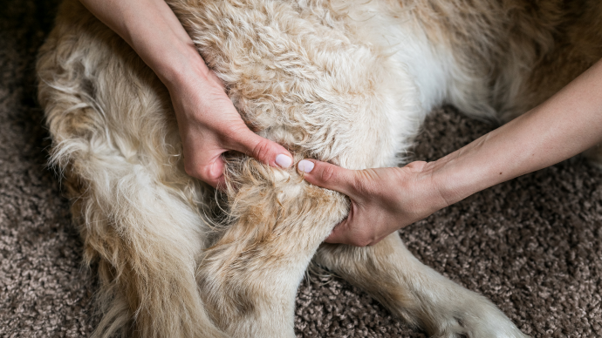What comes to mind when you think about massage? Most of us enjoy a massage to get rid of aches and pain, or even to relax those tense back, shoulder and neck muscles. We can feel the mental and physical benefits as it can de-stress our mind and body and make us feel calm again. So, what about canine massage - can this really be something that we can do for our dogs?
So, what is canine massage exactly?
We love to stroke and touch our dogs; it is one of the great pleasures of dog ownership! And luckily, our dogs love it too. There has been a lot of research into the social interactions between people and dogs and it is apparent that there are many physiological benefits for both parties. Heart rate and blood pressure are lowered, stress hormones decrease and there is an increase in the neurochemicals that facilitate social attachment and positive emotions. Touch provides affection, reassurance, and comfort.
Touch is a vital part of our everyday contact with our dogs (although obviously not for dogs that are hard shy or fearful of touch due to previous negative experiences). Touch is also a main part of canine massage so you can easily incorporate some massage techniques into your daily petting session.
What are the benefits of Canine Massage?
Canine massage has many benefits. It can build a bond between dog and owner (think of all those positive neurotransmitters being released!), it calms boisterous puppies, it helps less active older dogs by stimulating their lymphatic or venous systems and it is good for all other dogs too!
Massage also helps with repetitive stress injuries. Many owners don’t realise the importance of giving their dogs a warmup before exercise, or a cool down afterwards (simply walking the dog on a harness and lead can allow a warmup and cooldown). Also, bouts of infrequent over-exercise are common; often owners who work long hours during the week take their dogs for extra-long walks at weekends to compensate. However, this can cause muscle tears and stiffness, so any increase in exercise is built up slowly and gradually. Compare it to human athletes, as all of the same principles apply!
- Physical touch increases bonds between dog and caregiver
- Can help to identify injuries
- Can provide a great warmup before exercise
- Or even a warm down after exercise
- Can reduce stress and strains
- Can reduce the change of muscle tears and stiffness
- Can help a dog to heal faster if they are suffering from an injury
- Can help promote positive brain chemicals in canines
- Can increase overall happiness and wellbeing
What needs to be considered when massaging a dog?
Massage is a complementary therapy for canines, and as such, it works alongside conventional medical practices. Never do any type of massage if the dog seems unusually quiet or is off his food. Also, avoid it if the dog is injured or unwell – has vomited, has a fever etc. Massage should also never be done within two hours of feeding. It is also not appropriate if the dog has any open sores or wounds. If in any doubt about the suitability of massage for your dog, then consult your vet.
Things to remember:
- Massage at least 2 hours after food
- Do not massage if the dog has vomited or is unwell
- Do not massage if the dog has an injury unless you are properly trained or have been shown by a qualified canine professional such as a Veterinarian, Physiotherapist or Hydrotherapist
- Do not massage a dog if there are any open wounds or visible sores
- Make sure the dog is relaxed, and stop if the dog wants to move and get up
- Excessive yawning could also be a sign that your dog no longer wants to be touched

Massage has the best results when both you and the dog are relaxed. It is most important that you are calm, as dogs do pick up on our emotions! It is also ideal if you can do it in an environment where the dog is not stressed, so the dog’s home is best. Both you and the dog need to feel comfortable, and the dog needs to be able to move – stretch or rollover, for example.
Dogs are all different and all react to massage in different ways. Each massage must be adapted and adjusted to suit the dog and his needs, watching how he responds and keeping an eye on his body language. Some dogs relax straight away, whereas others take more time. Obviously, stop immediately if the dog doesn’t seem to be enjoying the experience – the dog needs to have a choice!
Is canine physiotherapy very difficult to study?
All dog owners can learn some basic techniques to use on their dogs. The easiest way to start is to just lay your hands on your dog – feel the muscle tension, the condition of the fur and the temperature. Putting one hand on the top of the spine (by the collar, on the neck) and the other at the base of the spine (at the top of the tail) and applying very gentle pressure will help to ground your dog if he is getting stressed or worried. The simplest massage movement is to keep your hand flat and make long sweeping strokes over your dog’s body. Always watch your dog carefully to see how he reacts and stop if there are any signs of discomfort or subtle signs of stress (he turns his head away from you, licks his lips, yawns).

However, if you want to use massage techniques on other dogs or learn more about exactly what is involved then you can take an accredited course. Professional canine therapy and rehabilitation therapists need to have recognised industry qualifications, but all dog owners who are interested in learning more about massage would benefit from taking a course. You will learn about things like anatomy, physiology and muscle groups, as well as all of the different massage techniques and when to use them.
Professional dog physiotherapists will also need to know how to evaluate each dog and then develop a treatment plan based on the dog’s needs, as well as understand the legal requirements and responsibilities. They can use their expert knowledge to work with specific health issues or injuries, whereas most owners just want to enrich the relationship they have with their dog.
What if I discover that my dog is in pain?
If you think your dog is showing signs of an injury, then it’s always best to take them to the vets to check. If in doubt, get them in front of a Veterinary professional as they will be to provide you with the best support and help your canine companion. A Veterinary specialist may even be able to identify what the issue is, provide medication and then recommend further therapies such as Canine Physiotherapy or Small Animal Hydrotherapy. Both types of therapies involve qualified canine professionals who are trained in handling dogs with various illnesses, injuries and conditions and will be able to support them through their recovery.
Most owners want their lives with their dogs to be a rewarding experience, for them and the dog. Canine massage (or mindful stroking) will further enhance this partnership, will give you a greater awareness and deeper understanding of your dog, and can help your dog live a healthier and happier life. There are amazing benefits to be gained from canine massage, so give it a go!
How do I study canine massage professionally?
A good place to start is with a course on this topic. We have developed a Canine Massage Diploma course that studies canine anatomy and physiology and will help gain an understanding of canine massage therapy. It is also a useful course for those who want to top up their continued professional development (CPD) as this course covers 60 hours of training.
Also, if you adore animals, you can keep track of all upcoming animal awareness days and events with our FREE calendar! Download it here.
















